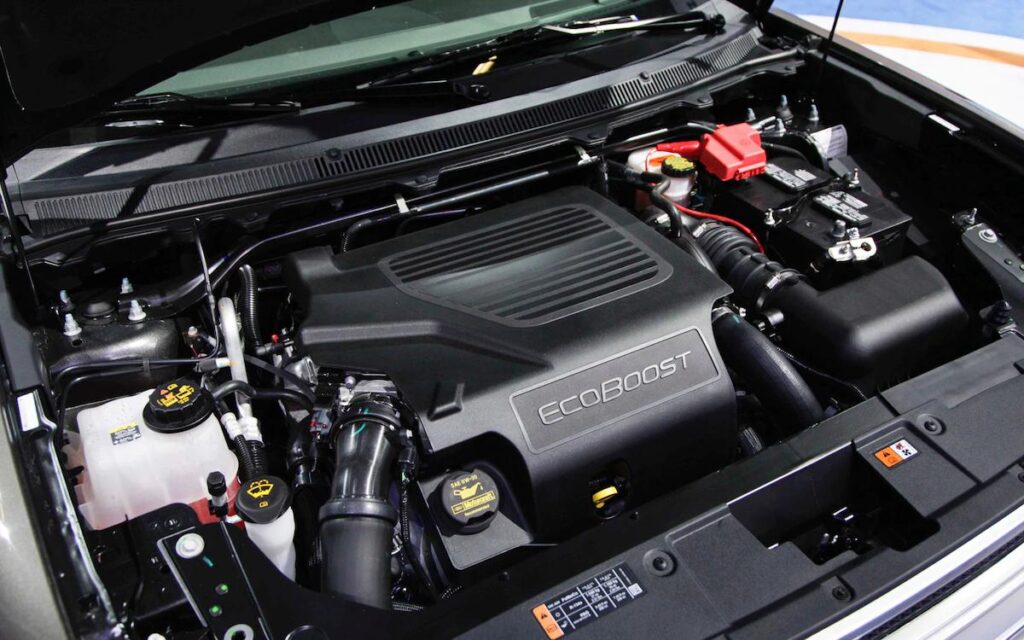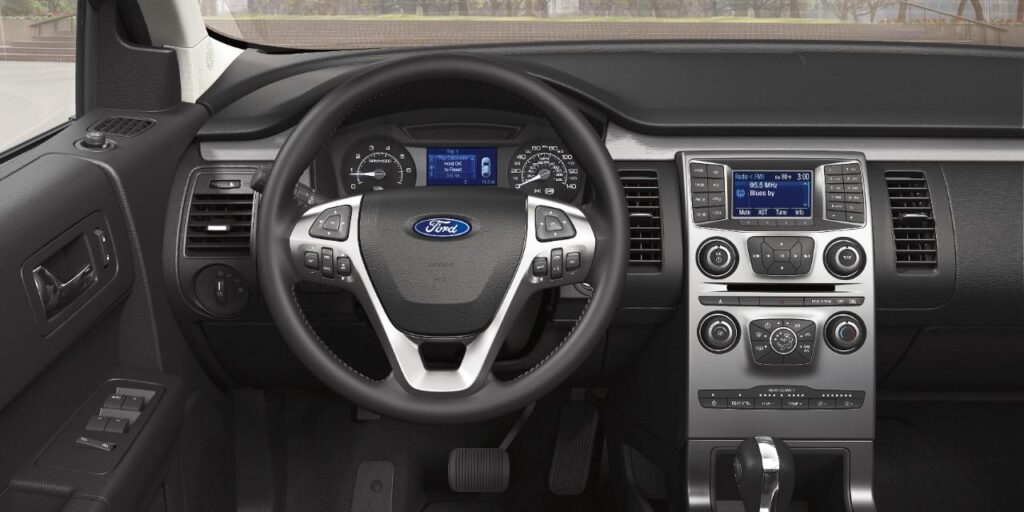The Ford Flex is a Used Car Hidden Gem

Contents
Mix one part minivan, one part wagon, add a dash of SUV, and what do you get? Probably something like the Ford Flex. It’s the Blue Oval’s recipe for stylish family transportation for folks who want something a little different — and, in many ways, better — than the standard fare.
The public got its first glimpse of the Flex at the 2005 Detroit Auto Show, where it was introduced as a concept vehicle. It was a hit, and Ford put the concept into production three years later, as a 2009 model, selling over 300,000 units during its ten-year run (2009-2019).
Ford discontinued the Flex in 2019. But that’s good news for used car buyers. The attributes that made it popular when new — its distinctive looks, spacious interior, and overall practicality — make it an even better used car. And thanks to depreciation, you can find a good used Flex for as little as $10,000.
Introduction
Ford based the Flex on an extended version of its D3 platform, which also underpins the sixth-generation Taurus, and built it alongside the related Ford Edge and Lincoln MKX (now called Nautilus) at its Oakville assembly plant in Ontario, Canada. The Flex took the place of the short-lived but popular Ford Freestyle in Ford’s product lineup.
Most reviewers heaped praise on the Flex when it was introduced in 2008 (as a 2009 model). In its first road test, Car and Driver called it “dazzling” and lauded its “Lexus-like attention to detail.” And Road & Track noted that it was “remarkably quiet, with a well controlled ride” and “the steering response of a much smaller car.”
The large crossover, which stretches to 201.8 inches and weighs nearly 4500 lbs, offers seating for seven, including room for two adults in the folding third row. Its shape, by noted designer Peter Horbury, cleverly hides this mass with horizontal lines running the length of the doors as well as a “floating roof,” with blacked-out roof pillars and an available contrasting white (or black) roof.
Engines and Transmissions
At launch, the Flex came standard with Ford’s 3.5 liter, dual overhead cam (DOHC) Duratec V6, producing 262 hp and 248 lb-ft of torque. Paired with a smooth-shifting 6-speed automatic transmission routing power to the front wheels, it pulls the Flex to 60 mph in about 8.5 seconds. That’s adequate for a large people mover.
But if you really need some get up and go, you’ll want the optional direct-injected and turbocharged version (“EcoBoost” in Ford lingo), which debuted for the 2010 model year. That mill generates almost 100 additional horses (355 total), shaving a full two seconds off sprints to 60 mph. Vehicles with the Ecoboost engine also boast manual shift paddles, which are sorely lacking on the base V6.

Ford offered all-wheel drive (AWD) on the Flex from the get-go, though only on the top two trim levels (SEL and Limited). Likewise, the EcoBoost engine came only on those two higher trims and was paired exclusively with AWD.
Fuel economy isn’t a strong suit of the Flex, as you can imagine for such a large car. With the base engine and front-wheel drive (FWD), the Flex is EPA-rated at 17 mpg city and 24 mpg highway. Adding AWD drops that to 16 mpg city and 22 mpg highway. Notably, the optional EcoBoost V6 doesn’t suffer any fuel economy penalty, at least as rated by the EPA. Its estimates match those of the base engine. However, unless you’re particularly easy on the go pedal, you should expect real world mileage with the EcoBoost to be lower.
In 2013, both engines received small power increases, with the naturally-aspirated V6 getting a nearly 10% bump to 285 hp, while the EcoBoost added 10 ponies for 365 hp. Fuel economy also increased slightly with the base V6, now returning 18 mpg city and 25 mpg highway in FWD spec, or 17 mpg city and 23 mpg highway with AWD. The Ecoboost was basically unchanged at 16 mpg city and 23 mph highway.
The Flex is capable of towing up to 4500 lbs with either engine.

Trims, Features, and Options
Ford sold the Flex in three trim levels: SE, SEL, and Limited. Each offers seating for six or seven, depending on the configuration of the second row, which was available standard as a three-seat bench or optionally as a pair of captain’s chairs. The third row, which can be folded flat into the cargo floor, also fits two adults comfortably, unlike many competing models.
The base SE trim provides basic amenities like 17-inch wheels, cloth seats, keyless entry, power windows and door locks, rear parking sensors, two-row air conditioning, and a six-speaker stereo (with Bluetooth capabilities for 2013 and later years).
The mid-level SEL adds larger 18-inch wheels, heated front seats, available leather upholstery, dual-zone automatic climate control, and Ford’s Bluetooth-enabled Sync infotainment system (optional on the SE). In 2013, a new version of Sync debuted, featuring the MyFord Touch interface with an 8-inch central touchscreen, navigation, and two USB ports. And in 2016, it was further upgraded to Sync 3, an improved and more responsive system featuring Apply CarPlay and Android Auto integration.
The top-of-the-line Limited trim further adds 19-inch alloys, perforated leather, xenon headlights, keyless ignition, a power lift gate, adjustable pedals, navigation, and interior upgrades like wood trim and ambient lighting.
In case the Limited trim isn’t fancy enough, in 2011 Ford introduced the Titanium package (later called the Appearance package), which upgrades the wheels to 20-inch chrome rims and also offers distinctive styling enhancements inside and out.
Other notable options include a multi-panel panoramic sunroof (dubbed “Vista Roof”), a tow package, DVD entertainment for the rear seats, and even a refrigerated console in the second row (when equipped with the available captain’s chairs). Models from 2013 and later were also available with adaptive cruise control, automated emergency braking, blind spot warnings, self parking, and ventilated front seats.

Problem Areas
The Ford Flex receives mostly good marks for reliability, with each model year earning an average or better dependability rating from JD Power. Still, if you’re shopping for a used Flex, there are a few problem areas to be aware of.
Swollen Lug Nuts
Owners of a variety of Ford vehicles from the mid-2010s (including the Flex) have complained of swollen lug nuts, which can bind to the bolts on the wheel hub, making it difficult (if not nearly impossible) to remove the wheels. This issue is apparently caused by the lug nuts’ two-piece construction, which can allow moisture inside, leading to swelling and corrosion.
While this is a relatively minor issue, it’s worth checking if you are looking at a used Flex for sale. If left unaddressed, it could cause you to need a tow truck for something as mundane as a flat tire.
Fortunately, the solution is quite simple. Just swap out the original two-piece lug nuts with standard one-piece units. Expect to pay about $150 for a new set of lugs.
Carbon Buildup in the Engine
Like many direct-injection engines, Ford’s 3.5 liter EcoBoost V6 can suffer from carbon buildup on and around the intake valves. In port-injected engines, these contaminants are washed away by fuel entering the cylinders. But direct injection places the fuel directly into each cylinder, allowing soot to build up over time. This can lead to problems like power loss, a rough idle, or hesitation and stumbling.
The fix for carbon buildup to blast away the residue using small soft particles like walnut shells. This service is typically needed once every 70,000 miles or so. If the car you’re looking at hasn’t had it done, expect to pay around $500 for the job.
Early Timing Chain Wear
The EcoBoost V6, especially those built before 2015, can suffer from stretching of the timing chain, which controls the major components of the engine. If the timing chain is loose, you might notice a rattle from the front of the engine at start up, a check engine light, or even engine misfiring and other drivability issues.
This issue can assert itself as early as 50,000 miles, though in many cases it appears much later (or possibly not at all). Oil changes on or before the factory recommended intervals can help to mitigate the issue. But once you have symptoms of a stretched timing chain, it’s important to address it. Left unattended, a worn timing chain can fail, wrecking the engine.
Unfortunately, replacing the timing chain and related components is a fairly major job. Expect to pay around $2500 for parts and labor at an independent mechanic.
Intercooler Condensation
Some owners with the optional EcoBoost V6 have reported issues with moisture and oil building up in the intercooler (which chills the air being fed into the combustion chamber). This problem shows up as hesitation, shuddering, or misfiring, especially under sudden acceleration, and it can also lead to early ignition component failures, including the spark plugs and coils.
The recommended fix for this problem is to install an aftermarket “catch can” to trap any oily water vapor before it enters the engine. Most Ford mechanics should be familiar with this installation, which typically runs about $400 for parts and labor. A few forums (such as this one) suggest an even cheaper fix: simply drilling a small hole (1/16th inch) in the intercooler inlet to allow the water and oil to drain to the ground.

What are the Best Years?
As with any used car, our overall advice for buying a used Ford Flex is to purchase the nicest one you can afford. The Flex was produced for a full decade, so prices range pretty widely, with early model years (pre-2013) towards the bottom end ($10,000-$15,000) and almost-new examples toward the top ($35,000+).
Trim and options also affect used Flex prices. When new, a Flex in base SE trim stickered for about $33,000, while a fully-optioned Flex in Limited trim could approach $50,000. Likewise, a used Flex loaded with options will typically be thousands more than a lightly-optioned example from a similar year with similar miles.
Thanks to all of the improvements that Ford made to the Flex through the years, we recommend buying a 2013 or later model, if you can afford it. That was the year the Flex went through a significant model refresh, which updated the looks and also introduced a host of modern tech, including adaptive cruise control and automatic emergency braking. Good specimens from 2013-2015 generally sell for around $15,000-$20,000.
Even better are models from 2016 and later, which include the vastly improved Sync 3 infotainment system as well as a factory fix for the EcoBoost timing chain issue (noted above). However, they’ll set you back a bit more cash. Good used Flexes from 2016-2019 generally start around $20,000 and can quickly climb to $30,000 or more, depending on the miles, year, and options.
If your budget won’t stretch that far, don’t fret. You can still buy a well-kept used Flex from one of the first few years (2009-2012) with under 100,000 miles for $10,000-$15,000. Most examples at this price point will lack some desirable options like all-wheel drive or the more powerful EcoBoost engine. Nevertheless, they still represent an outstanding value.
It’s possible a used Flex for less than $10,000, but it will likely have 150,000+ miles as well as some significant flaws, such as minor cosmetic damage, deferred maintenance (e.g. worn tires), and/or perhaps an accident on its vehicle history report. At this price point, we advise you to tread carefully.
Before you spend ten grand or more on a used Flex, we highly recommend hiring a Ford specialist to evaluate it. For about $250, they’ll provide you with a thorough inspection of the entire car. This can reveal major, deal-breaking issues, like hidden damage from an accident, or minor things that you can use as bargaining points, like worn brake pads. Either way, it’s easily worth the money to complete a professional inspection prior to finalizing any used car purchase.
To learn more about finding a good local mechanic, check out our article, How to Find a Good Auto Mechanic That You Can Trust.

The Bottom Line
The Ford Flex may be hard to categorize. Is it a wagon? An SUV? A minivan? Whatever you call it, there’s no denying it’s a comfortable and stylish people mover. It also boasts good power, especially from the optional EcoBoost V6, and can be equipped with a surprising list of amenities, including ventilated seats and a built-in refrigerator, that you might expect to find only in the likes of a Bentley.
While the Flex was always somewhat of a niche vehicle, selling only about 25,000 units per year, its 10-year production run guarantees that there is almost always a healthy supply of used inventory out there to choose from, fitting budgets from $10,000 to $40,000 and everywhere in between.
We suppose that makes the Flex one of the most, well, flex-ible used car buys out there.
Photos courtesy of Ford
